Inspirational Teaching
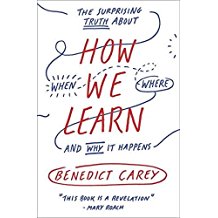 How we learn: the surprising truth about when, where, and why it happens
How we learn: the surprising truth about when, where, and why it happens
by Benedict Carey
Benedict Carey's How We Learn focuses on the process of enhancing and exercising our memories to achieve positive results in memorization. He goes in depth in helping his readers register, store, and retrieve information through several techniques, ranging from beginners to advanced. Repetition is a vital part of Carey's approach.
 Make it stick: the science of successful learning
Make it stick: the science of successful learning
by Peter C. Brown and Henry L. Roediger III
Drawing on discoveries in cognitive psychology and other disciplines, the authors offer concrete techniques for becoming more productive learners. New insights into how memory is encoded, consolidated, and later retrieved have led to a better understanding of how we learn. Grappling with the impediments that make learning challenging leads both to more complex mastery and better retention of what was learned. More complex and durable learning come from self-testing, introducing certain difficulties in practice, waiting to re-study new material until a little forgetting has set in, and interleaving the practice of one skill or topic with another. Make It Stick will appeal to all those interested in the challenge of lifelong learning and self-improvement.
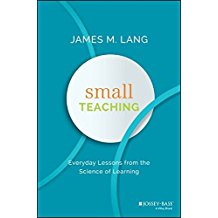 Small teaching: everyday lessons from the science of learning
Small teaching: everyday lessons from the science of learning
by James M. Lang
In Small Teaching, James Lang presents a strategy for improving student learning with a series of modest but powerful changes that make a big difference—many of which can be put into practice in a single class period - by employing cognitive theory. These strategies are designed to bridge the chasm between primary research and the classroom environment regardless of discipline. Small teaching techniques include brief classroom or online learning activities, one-time interventions, and small modifications in course design or communication with students.
 Turning learning right side up: putting education back on track
Turning learning right side up: putting education back on track
by Russell Ackoff and Daniel Greenberg
In Turning Learning Right Side Up, the authors develop a provocative conversation to answer the very deepest questions about education: What should be its true purpose? Do classrooms make sense anymore? What should individuals contribute to their own education? Are yesterday’s distinctions between subjects--and between the arts and sciences--still meaningful? What would the ideal lifelong education look like? They combine deep idealism with a relentless focus on the real world to arrive at solutions that are profoundly sensible and powerfully compelling.
 What the best college students do
What the best college students do
by Ken Bain
From the author of the best-selling book What the Best College Teachers Do is a book aimed at inspiring students who want to get the most out of college. The first thing students should do is think beyond the transcript. The creative, successful people profiled in this book used their four years to cultivate habits of thought that would enable them to grow and adapt throughout their lives. These movers and shakers didn’t achieve success by making success their goal. For them, it was a byproduct of following their intellectual curiosity, solving useful problems, and taking risks in order to learn and grow. Teachers will also find the book inspiring and educational in their understanding of themselves and students.
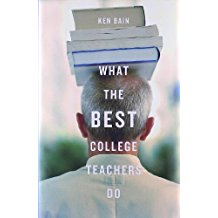 What the best college teachers do
What the best college teachers do
by Ken Bain
What makes a great teacher great? Who are the professors students remember long after graduation? The short answer is--it's not what teachers do, it's what they understand. Lesson plans and lecture notes matter less than the special way teachers comprehend the subject and value human learning. The best teachers know their subjects inside and out but they also know how to engage and challenge students and to provoke impassioned responses. Most of all, they believe two things fervently: that teaching matters and that students can learn. In stories both humorous and touching, Bain describes examples of ingenuity and compassion, of students' discoveries of new ideas and the depth of their own potential.
Bookshelf Essentials
Assessment of Learning
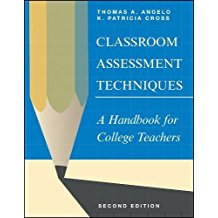 Classroom assessment techniques: a handbook for college teachers
Classroom assessment techniques: a handbook for college teachers
by Thomas A. Angelo and K. Patricia Cross
This revised and greatly expanded edition of the handbook offers teachers at all levels how-to advise on classroom assessment. Along with down-to-earth explanations of what classroom assessment entails and how to plan, implement, and analyze assessment projects, the authors provide fifty classroom assessment techniques and step-by-step procedures for administering the techniques and analyzing the data.
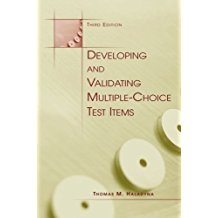 Developing and validating multiple-choice test items
Developing and validating multiple-choice test items
by Thomas M. Haladyna
This book is intended for anyone who is seriously interested in designing and validating multiple-choice test items that measure understanding and the application of knowledge and skills to complex situations, such as critical thinking and problem solving. The author provides information about writing items that match content standards, creating item pools and item banking and item-writing rules. He even includes hundreds of exemplary items and procedures that speed up item development.
 Effective grading: a tool for learning and assessment in college
Effective grading: a tool for learning and assessment in college
by Barbara E. Walvoord and Virginia Johnson Anderson
Effective Grading provides a proven hands-on guide for evaluating student work and offers an in-depth examination of the link between teaching and grading. Authors explain that grades are not isolated artifacts but part of a process that, when integrated with course objectives, provides rich information about student learning, as well as being a tool for learning itself. The authors show how the grading process can be used for broader assessment objectives, such as curriculum and institutional assessment.
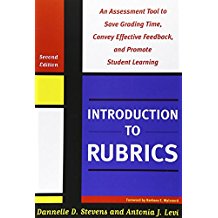 Introduction to rubrics: an assessment tool to save grading time, convey effective feedback, and promote student learning
Introduction to rubrics: an assessment tool to save grading time, convey effective feedback, and promote student learning
by Dannelle D. Stevens and Antonia J. Levi
This book provides a fundamental introduction to the principles and purposes of rubrics, with guidance on how to construct them, use them to align course content to learning outcomes, and apply them in a wide variety of courses, and to all forms of assignment. With clarity and practicality, the authors address a variety of rubric types, pros and cons of "ready-made" rubrics, use of rubrics to improve your teaching and in the scholarship of teaching and learning.
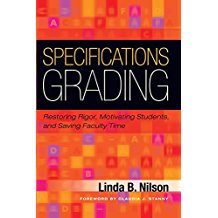 Specification grading: restoring rigor, motivating students, and saving faculty time
Specification grading: restoring rigor, motivating students, and saving faculty time
by Linda Nilson and Claudia J. Stanny
Specifications grading restructures assessments to reduce grading time, empower students to choose the level of attainment they want to achieve, reduce antagonism between the evaluator and the evaluated, and increase student receptivity to meaningful feedback, thus facilitating the learning process. Among the unique characteristics of the schema are the elimination of partial credit, the reliance on a one-level grading rubric and the “bundling” of assignments and tests around learning outcomes. Specs grading works equally well in small and large class settings, encourages “authentic assessment,” and makes transparent to all stakeholders the learning outcomes that students achieve.
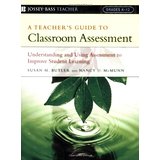 A teacher's guide to classroom assessment: understanding and using assessment to improve student learning
A teacher's guide to classroom assessment: understanding and using assessment to improve student learning
by Susan M. Butler and Nancy D. McMunn
A Teacher’s Guide to Classroom Assessment is a comprehensive step-by-step guide to effectively integrate assessment into the classroom. Written for both new and seasoned teachers, this important book offers a practical aid for developing assessment skills and strategies, building assessment literacy, and ultimately improving student learning. Based on extensive research, this book is filled with illustrative, down-to-earth examples of how classroom assessment works in classrooms where assessment drives the instruction. The authors present the Classroom Assessment Cycle that demonstrates how one assessment action must flow into the next to be effective.
Course Development
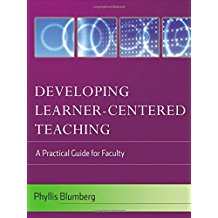 Developing learner-centered teaching: a practical guide for faculty
Developing learner-centered teaching: a practical guide for faculty
by Phyllis Blumberg and Maryellen Weimer
Developing Learner-Centered Teaching offers a step-by-step plan for transforming any course from teacher-centered to the more engaging learner-centered model. Filled with self-assessments and worksheets that are based on each of the five practices identified in Maryellen Weimer's Learner-Centered Teaching, this groundbreaking book gives instructors, faculty developers, and instructional designers a practical and effective resource for putting the learner-centered model into action.
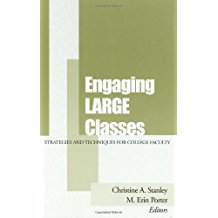 Engaging large classes: strategies and techniques for college faculty
Engaging large classes: strategies and techniques for college faculty
by Christine A. Stanley and M. Erin Porter
In Engaging Large Classes, the authors demonstrate that large classes can be just as stimulating and rewarding as smaller classes. This book provides instructional strategies and advice on how to design, plan, manage, and assess large classes, along with strategies for using classroom technology, active learning, and collaborative learning.
 Learner-centered teaching: five key changes to practice
Learner-centered teaching: five key changes to practice
by Maryellen Weimer
This book offers a comprehensive introduction to the topic of learner-centered teaching in the university classroom. Learner-centered teaching focuses attention on what the student is learning, how the student is learning, the conditions under which the student is learning, whether the student is retaining and applying the learning, and how current learning positions the student for future learning. The book also offers well-researched advice for educators who want to transition to a learner-centered approach in their classrooms and identifies the steps to take to put into place learner-centered policies and practices.
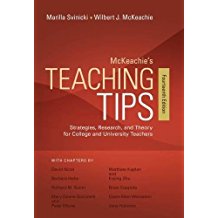 McKeachie's teaching tips
McKeachie's teaching tips
by Wilbert McKeachie and Marilla Svinicki
This handbook provides helpful strategies for dealing with both the everyday challenges of university teaching and those that arise in efforts to maximize learning for every student. The suggested strategies are supported by research and adaptable to specific classroom situations. Rather than suggest a "set of recipes" to be followed mechanically, the book gives instructors the tools they need to deal with the ever-changing dynamics of teaching and learning.
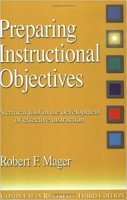 Preparing instructional objectives: a critical tool in the development of effective instruction
Preparing instructional objectives: a critical tool in the development of effective instruction
by Robert F. Mager
Before you prepare instruction, it's important to be able to clearly state what the desired outcomes of that instruction should be. In Preparing Instructional Objectives, the authors describe the characteristics of well-stated objectives, how to derive suitable objectives, and how to write objectives to match the instructional results you are seeking to achieve.
 Style: lessons in clarity and grace
Style: lessons in clarity and grace
by Joseph F. Williams and Joseph Bizup
Aimed at English and writing courses, Style: Lessons in Clarity and Grace asserts that style is a matter of making informed choices in the service of one’s readers. While writers know best what they want to say, readers ultimately decide if they’ve said it well. This flagship text builds on that premise, with updates on subjects such as gender-neutral writing and writing for global audiences. It brings the authors’ innovative approach to the needs of today’s students, while maintaining that writing with style is a civic and ethical virtue.
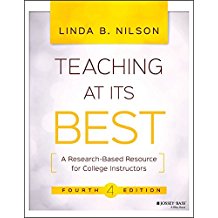 Teaching at its best: a research-based resource for college instructors
Teaching at its best: a research-based resource for college instructors
by Linda B. Nilson
Teaching at Its Best is the bestselling, research-based toolbox packed with practical guidance, proven techniques, and expert perspectives. This book features guidance on building critical thinking into course design, creating a welcoming classroom environment, helping students learn how to learn, giving and receiving feedback, and teaching in multiple modes, along with the latest on flipped classroom, cutting-edge technologies, self-regulated learning, and the mental processes involved in learning and memory.
Documentation and Scholarship of Teaching
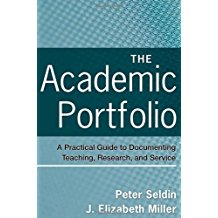 The academic portfolio: a practical guide to documenting teaching, research, and service
The academic portfolio: a practical guide to documenting teaching, research, and service
by Peter Seldin and J. Elizabeth Miller
The authors identify key issues, red flag warnings, and benchmarks for success, describing the what, why, and how of developing academic portfolios. The book includes a step-by-step approach to creating portfolios and lists 21 possible portfolio items covering teaching, research/scholarship, and service from which faculty can choose the ones most relevant to them. It includes a research-based rubric and examines specific guiding questions to consider when preparing every subsection of the portfolio.
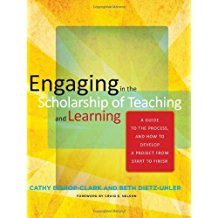 Engaging in the scholarship of teaching and learning: a guide to the process and how to develop a project from start to finish
Engaging in the scholarship of teaching and learning: a guide to the process and how to develop a project from start to finish
by Cathy Bishop-Clark and Beth Dietz-Uhler
This book provides prospective scholarship of teaching and learning (SoTL) scholars with the necessary background information, foundational theory, tools, resources, and methodology to develop their own projects through a five-stage process. Each stage is illustrated by examples of actual SoTL studies and is accompanied by worksheets to help the reader.
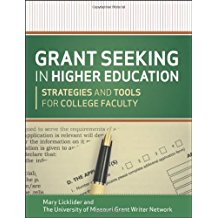 Grant seeking in higher education: strategies and tools for college faculty
Grant seeking in higher education: strategies and tools for college faculty
by Mary M. Licklider
Written for anyone in higher education who is responsible for submitting and running a grant-funded project, Grant Seeking in Higher Education offers a hands-on resource for developing and managing the grant process from start to finish, including a toolkit of tested materials. The authors help the reader to identify and sort through potential sponsors, tap into campus support that is already in place, and prepare to write a targeted grant proposal that can generate results. Once you have completed the research, the book outlines the keys to writing a winning proposal, including an effective proposal narrative, thorough budget, and readable proposal package.
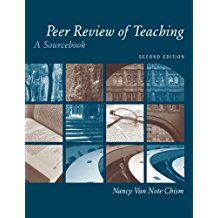 Peer review of teaching: a sourcebook
Peer review of teaching: a sourcebook
by Nancy Van Note Chism
This book aims through examples and suggestions to empower faculty to articulate criteria and standards for peer review, perform the reviews systematically and thoughtfully, and realize that engaging in peer review is an approachable and worthwhile professional task, while emphasizing student learning as the ultimate goal of college teaching.
 Scholarship reconsidered: priorities of the professoriate
Scholarship reconsidered: priorities of the professoriate
by Ernest L. Boyer
Boyer's landmark book challenged the publish-or-perish status quo that dominated the academic landscape for generations. His powerful and enduring argument for a new approach to faculty roles and rewards continues to play a significant part of the national conversation on scholarship in the academy. With the rise of the non-tenure-track faculty, Boyer calls for a broadened view of scholarship.
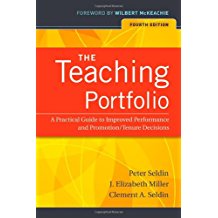 Teaching portfolio: a practical guide to improved performance and promotion/tenure decisions
Teaching portfolio: a practical guide to improved performance and promotion/tenure decisions
by Peter Seldin, J. Elizabeth Miller, and Clement A. Seldin
This book is practical essential resource for faculty seeking promotion/tenure or who want to improve their teaching. It book offers guidelines and models that faculty need to prepare quality portfolios focused on reflection, sound assessment, and collaboration. The book also provides guidance on how to evaluate portfolios with a validated template.
CETL is continuing to build a library of titles of interest to be used by faculty members and graduate students. If you would like to borrow any of the following books or videos, please contact Stacey Valliere, stacey.valliere@uconn.edu (860-486-2686), we are located in ROWE 331.
Books and videos are due back in 30 days.
View A List of Our Videos
Best Practices in Flipped Class Design, DVD 40 minutes
See how the flipped learning model can meet the challenges of today’s student body. This seminar gives you the knowledge about how flipped learning works in different disciplines and the conceptual tools for constructing a flipped classroom of your own.
Declining by Degrees: Higher Education at Risk, DVD 120 minutes
Veteran correspondent John Merrow takes viewers behind the scenes of American higher education to experience college through the eyes of students, professor, and college administrators. Set on four different college campuses across the country-a private liberal arts college, a major state university, a regional public university, and a community College- Declining by Degrees examines both the promis and the peril in higher education today.
Designing & Teaching a Course with a Critical Thinking Focus, DVD 60 minutes
Critical thinking is a skill that students in all disciplines must master. This seminar leads educators through the process of developing and teaching a discipline-based course that targets critical thinking skills and shows participants how to effectively encourage students to think for themselves.
How Can I Be an Effective Mentor?, DVD 20 minutes
Learn the essential principles to effectively advise and coach junior faculty while meeting all your other responsibilities. This program will show you how to start your mentoring relationship off on the right foot and carry it through to a successful conclusion.
How Can I Best Learn from My Mentor?, DVD 20 minutes
It’s challenging to teaching, research, and citizenship responsibilities of higher education faculty. This program shows you how to find and make the most of the help of a mentor. Gain insights you can use to learn from others, avoid common pitfalls, and support your tenure review process.
How Do I Include Introverts in Class Discussions?, DVD 20 minutes
Introverted students can find themselves at a disadvantage in the contemporary college classroom. Learn effective teaching strategies to engage introverted students in class discussions and how to guide them beyond their comfort zones.
Is Your Syllabus Sending the Wring Message?, DVD 20 minutes
Your syllabus and classroom policies set the tone for your class, but they may not be creating a welcoming learning environment. Learn tips designed to help you use classroom policies to support student engagement and a smooth-running classroom.
Quick Links
- Professional Development Resources
- Education-Related Conferences
- The Teaching Professor and Magna Digital Library
- National Center for Faculty Development and Diversity
- Teaching and Learning Academy by Gardner Institute
- Inclusive STEM Teaching Project
- Faculty Spotlights
- Dr. Daniel Burkey (School of Engineering)
- Dr. Milagros Castillo Montoya (Neag School of Education)
- Dr. Xinnian Chen (CLAS Physiology and Neurobiology)
- Dr. Mitch Green (CLAS, Philosophy)
- Dr. Shareen Hertel (CLAS, Political Science)
- Dr. Jamie Kleinman (CLAS, Department of Psychology)
- Dr. John Redden (CLAS, Department of Physiology & Neurobiology)
- Dr. Amit Savkar (CLAS, Department of Mathematics)
- Readings
- Videos